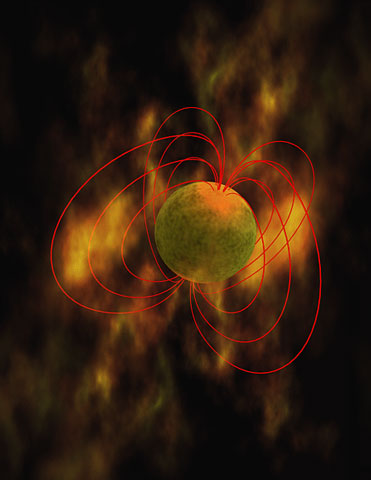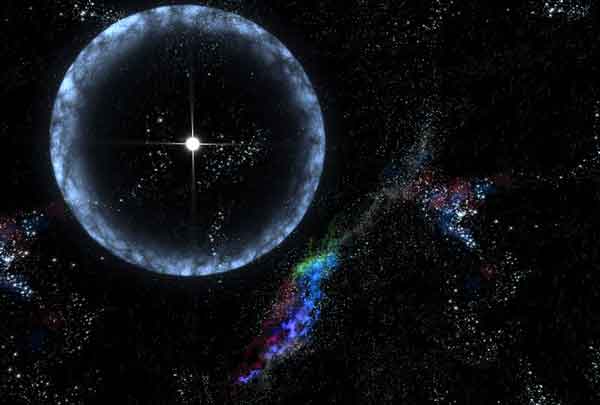- ^ a b Ward; Brownlee, p.286
- ^ a b c d Kouveliotou, C.; Duncan, R. C.; Thompson, C. (February 2003). "Magnetars". Scientific American; Page 35.
- ^ Magnetar (1999). Retrieved on 17 December 2007.
- ^ Magnetars, Soft Gamma Repeaters and Very Strong Magnetic Fields. Robert C. Duncan, University of Texas at Austin (March 2003). Retrieved on 2007-05-23.
- ^ a b c Kouveliotou, C.; Duncan, R. C.; Thompson, C. (February 2003). "Magnetars". Scientific American; Page 36.
- ^ "The Brightest Blast". Retrieved on 17 December 2007.
- ^ "Magnetar" discovery solves 19-year-old mystery. Retrieved on 17 December 2007.
- ^ Cosmic Explosion Among the Brightest in Recorded History. Retrieved on 17 December 2007.
- ^ Kouveliotou, p.237
- ^ S. B. Popov, M. E. Prokhorov Progenitors with enhanced rotation and the origin of magnetars. Monthly Notices of the Royal Astronomical Society 367 (2), 732–736.
- ^ Jekyll-Hyde neutron star discovered by researchers McGill
- ^ Full listing of magnetars known. Retrieved on 17 December 2007.
|
|
Artist's conception of a magnetar, with magnetic field lines A magnetar is a neutron star with an extremely powerful magnetic field, the decay of which powers the emission of copious amounts of high-energy electromagnetic radiation, particularly X-rays and gamma-rays.[1] The theory regarding these objects was formulated by Robert Duncan and Christopher Thompson in 1992, but the first recorded burst of gamma rays thought to have been from a magnetar was on March 5, 1979.[2] During the following decade, the magnetar hypothesis has become widely accepted as a likely explanation for soft gamma repeaters and anomalous X-ray pulsars. Description Little is known about the physical structure of a magnetar, because none are close to Earth. Magnetars are somewhere around 20 kilometres in diameter. Despite this, they are many times more massive than our Sun. Magnetars are so compressed that a thimbleful of its material is estimated to weigh over 100 million tons.[1] Most magnetars recorded rotate very rapidly, at least several times per second.[3] The active life of a magnetar is short. Their strong magnetic fields decay after about 10,000 years, after which point activity and strong X-ray emission cease. Given the number of magnetars observable today, one estimate puts the number of "dead" magnetars in the Milky Way at 30 million or more.[4] Quakes triggered on the surface of the magnetar cause great volatility in the star and the magnetic field which encompasses it, often leading to extremely powerful gamma ray flare emissions which have been recorded on Earth in 1979, 1998 and 2004.[5] Magnetic field Magnetars are primarily characterised by their extremely powerful magnetic field, which can often reach the order of 10 gigateslas. These magnetic fields are millions of times stronger than any man-made magnet, and quadrillions of times more powerful than the field surrounding Earth.[6] As of today, they are the most magnetic objects ever detected in the universe.[5][7] A magnetic field of 10 gigateslas is enormous. Earth has a geomagnetic field of 30-60 microteslas, and a neodymium based rare earth magnet has a field of about 1 tesla, with a magnetic energy density of 4.0 x 105 J/m3. A 10 gigatesla field, by contrast, has an energy density of 4.0 x 1025 J/m3, with an E/c2 mass density >104 times that of lead. The magnetic field of a magnetar would be lethal even at a distance of 1000 km, tearing tissues due to the diamagnetism of water. It has even been said that at a distance halfway to the moon, a magnetar could strip information from a credit card on Earth.[8] As described in a 2003 Scientific American cover story, remarkable things happen within a magnetic field of magnetar strength: X-ray photons readily split in two or merge together. Also, when entering the magnetic field, photons of polarized light change speed (and therefore wavelength). Since the field can prevent electrons from vibrating as they normally do in response to light, light waves can slip past electrons without losing energy. Empty space itself experiences vacuum birefringence, gaining the ability to split light into different polarizations (like an immaterial version of a calcite crystal).[2] The field also stretches atoms into long cylinders. In a field of about 105 teslas atomic orbitals deform into cigar shapes. At 1010 teslas, a hydrogen atom becomes a spindle 200 times narrower than its normal diameter.[2] Formation When, in a supernova, a star collapses to a neutron star, its magnetic field increases dramatically in strength (halving a linear dimension increases the magnetic field fourfold). Duncan and Thompson calculated that the magnetic field of a neutron star, normally an already enormous 108 teslas could, through the dynamo mechanism, grow even larger, to more than 1011 teslas (or 1015 gauss). The result is a magnetar.[9] The supernova might lose 10% of its mass in the explosion. In order for such large stars (10–30 solar masses) not to collapse straight into a black hole, they have to shed a larger proportion of their mass— perhaps another 80%. It is estimated that about 1 in 10 supernova explosions results in a magnetar rather than a more standard neutron star or pulsar.[10] On February 21, 2008 it was announced that NASA and McGill University researchers had discovered neutron star that morphs from a pulsar to a magnetar. This indicates that magnetars are not merely a rare type of pulsar but may be a (possibly reversable) phase in the lives of at least some pulsars.[11] History 1979 discovery On March 5, 1979, a few months after the successful dropping of satellites into the atmosphere of Venus, the two Soviet spacecrafts that were then drifting through the solar system, were hit by a blast of gamma ray radiation at approximately 10:51 EST. This contact raised the radiation readings on both the probes from a normal 100 counts per second to over 200,000 counts a second, in only a fraction of a millisecond.[2] This burst of gamma rays quickly continued to spread. Eleven seconds later, Helios 2, a NASA probe, which was in orbit around the Sun, was saturated by the blast of radiation. It soon hit Venus, and the Pioneer Venus Orbiter's detectors were overcome by the wave. Seconds later, Earth received the wave of radiation, where the powerful output of gamma rays inundated the detectors of three U.S. Department of Defence Vela satellites, the Soviet Prognoz 7 satellite, and the Einstein Observatory. Just before the wave exited the solar system, the blast also hit the International Sun-Earth Explorer. This extremely powerful blast of gamma ray radiation constituted the strongest wave of extra-solar gamma rays ever detected; it was over 100 times more intense than any known previous extra-solar burst.[5] Known magnetars Examples of known magnetars include * SGR 1806-20, located 50,000 light-years from Earth on the far side of our Milky Way galaxy in the constellation of Sagittarius. * SGR 1900+14, located 20,000 light-years away in the constellation Aquila. After a long period of low emissions (significant bursts only in 1979 and 1993) it became active in May-August 1998, and a burst detected on August 27, 1998 was of sufficient power to force NEAR to shut-down to prevent damage and to saturate instruments on BeppoSAX, WIND and RXTE. * 1E 1048.1-5937, located 9,000 light-years away in the constellation Carina. The original star, from which the magnetar formed, had a mass 30 to 40 times that of the Sun.
On 27 December, 2004, SGR 1806-20 (artist's conception shown) released a burst of gamma rays so powerful that it had effects on Earth's atmosphere, at a range of over 50,000 light years. A full listing is given in the magnetar catalog.[12] As of May 2007, 12 magnetars are known, with three more candidates awaiting confirmation. See also * Neutron star References Specific
Books and literature * Peter Douglas Ward, Donald Brownlee Rare Earth: Why Complex Life Is Uncommon in the Universe. Springer, 2000. ISBN 0387987010. * Chryssa Kouveliotou The Neutron Star-Black Hole Connection. Springer, 2001. ISBN 140200205X. General * "Origin of magnetars", CNN, 2 February 2005. * "The Brightest Blast", Sky and Telescope, 18 February 2005. Links
Retrieved from "http://en.wikipedia.org/"
|
|



